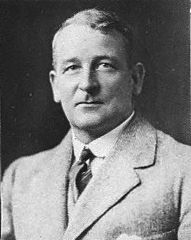
The 1931 New Zealand general election was a nationwide vote to determine the shape of the New Zealand Parliament's 24th term. It resulted in the newly formed coalition between the United Party and the Reform Party remaining in office as the United–Reform Coalition Government, although the opposition Labour Party made some minor gains despite tallying more votes than any other single party.

The 24th New Zealand Parliament was a term of the New Zealand Parliament. It opened on 23 February 1932, following the 1931 election. It was dissolved on 1 November 1935 in preparation for the 1935 election. The 24th Parliament was extended by one year because the 1935 election was held later than anticipated due to the ongoing depression, similarly the 1919, and the 1943 elections were held two years late, having been postponed during World War I and World War II respectively.

The 1890 New Zealand general election was one of New Zealand's most significant. It marked the beginning of party politics in New Zealand with the formation of the Liberal Government, which was to enact major welfare, labour and electoral reforms, including giving the vote to women.

The 1896 New Zealand general election was held on Wednesday, 4 December in the general electorates, and on Thursday, 19 December in the Māori electorates to elect a total of 74 MPs to the 13th session of the New Zealand Parliament. A total number of 337,024 (76.1%) voters turned out to vote.
Timaru was a parliamentary electorate, in New Zealand's South Island. It existed continuously from 1861 to 1996 and was represented by eleven Members of Parliament.
Inangahua is a former parliamentary electorate in the Buller District, which is part of the West Coast region of New Zealand, from 1881 to 1896. The town of Inangahua Junction, which gave the electorate its name, was located in the adjacent Buller electorate until 1887.
Geraldine was a former parliamentary electorate in the South Canterbury region of New Zealand that existed three times from 1875 to 1911. It was represented by six Members of Parliament.
Gladstone was a parliamentary electorate in the Canterbury region of New Zealand, from 1866 to 1890.

Thomas David Burnett was a New Zealand politician of the Reform Party, and joined the National Party after the 1935 election.
Christchurch was a parliamentary electorate in Christchurch, New Zealand. It existed three times. Originally it was the Town of Christchurch from 1853 to 1860. From the 1860–1861 election to the 1871 election, it existed as City of Christchurch. It then existed from the 1875–1876 election until the 1881 election. The last period was from the 1890 election to the 1905 election. Since the 1946 election, a similarly named electorate called Christchurch Central has been in existence.

Thomas Shailer Weston, often referred to as Thomas S. Weston, was a judge and 19th-century Member of Parliament from Westland, New Zealand. Weston was the patriarch of one of two dominant Canterbury families of the legal profession.

The 13th New Zealand Parliament was a term of the New Zealand Parliament. It was elected at the 1896 general election in December of that year.

The Selwyn by-election of 1884 was a by-election held on 15 February 1884 during the 8th New Zealand Parliament in the rural Canterbury electorate of Selwyn.

The Timaru by-election 1962 was a by-election held in the Timaru electorate in Canterbury during the term of the 33rd New Zealand Parliament, on 21 July 1962.
The 1890 Timaru by-election was a by-election held on 18 August 1890 during the 10th New Zealand Parliament in the seat of Timaru, a partly urban seat in Canterbury on the East Coast of the South Island.
The 1868 Timaru by-election was a by-election held on 20 November in the Timaru electorate during the 4th New Zealand Parliament.
The 1878 Grey Valley by-election was a by-election held on 22 May 1878 during the 6th New Zealand Parliament in the West Coast electorate of Grey Valley.
The 1969 New Year Honours in New Zealand were appointments by Elizabeth II on the advice of the New Zealand government to various orders and honours to reward and highlight good works by New Zealanders. The awards celebrated the passing of 1968 and the beginning of 1969, and were announced on 1 January 1969.

Edward Percy Sealy, also referred to as Edwin Sealy, was a New Zealand surveyor, photographer, explorer, farmer, and entomologist. Born into a wealthy English family, Edward and his elder brother Henry received a good education but were orphaned at a young age. The brothers emigrated to New Zealand and Edward was 19 when they arrived in 1859. They initially spent time with a relative in the Hawke's Bay Region from whom Edward learned photography. The brothers became surveyors in the Hawke's Bay and then worked for the Canterbury Provincial Council in this trade. They were involved in a very public scandal in 1876 when Edward beat a prominent member of parliament to some land that they were both interested in based on insider information that had been passed on by his brother. Both Sealy brothers were also farmers, with Henry engaging in much land speculation. They built family mansions next to each other in 1875 just outside of Timaru after they both married. His brother lost his house in the economic downturn that started in the late 1870s.

St Mary's Church is a heritage-listed Anglican church located in Timaru, in the Canterbury region on the South Island of New Zealand. One of the defining landmarks in Timaru, the present church was built in three stages in 1880, consecrated in 1886, with the distinct tower added in 1910.










